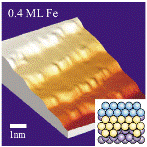Department of Physics and Astronomy: Publications and Other Research
Date of this Version
2007
Abstract
The growth and magnetism of nanometer size Fe clusters on stepped Pt surfaces is investigated by scanning tunneling microscopy (STM) and magneto-optical Kerr effect measurements (MOKE). The clusters are formed on xenon buffer layers of varying thickness and then brought into contact with the substrate by thermal desorption of the Xe. The cluster size is controlled by the thickness of the Xe layer. It is found that clusters of diameter smaller than the Pt terrace width of 2 nm are aligned along the step edges of the Pt(997), thus forming linear cluster chains. In this arrangement, the clusters are ferromagnetic with an easy axis in the direction along the surface normal. If the cluster diameter is larger than the terrace width then the alignment along the step edges is not observed and rather large agglomerates are found which are randomly distributed over the surface. Despite their increased volume, such agglomerates are superparamagnetic with in-plane easy magnetization axis. The enhanced magnetic anisotropy energy in the smallest clusters is originating from hybridization effects at the Fe-Pt interface.


Comments
Published in Eur. Phys. J. D 45, 515–520 (2007). Copyright © EDP Sciences. Used by permission.